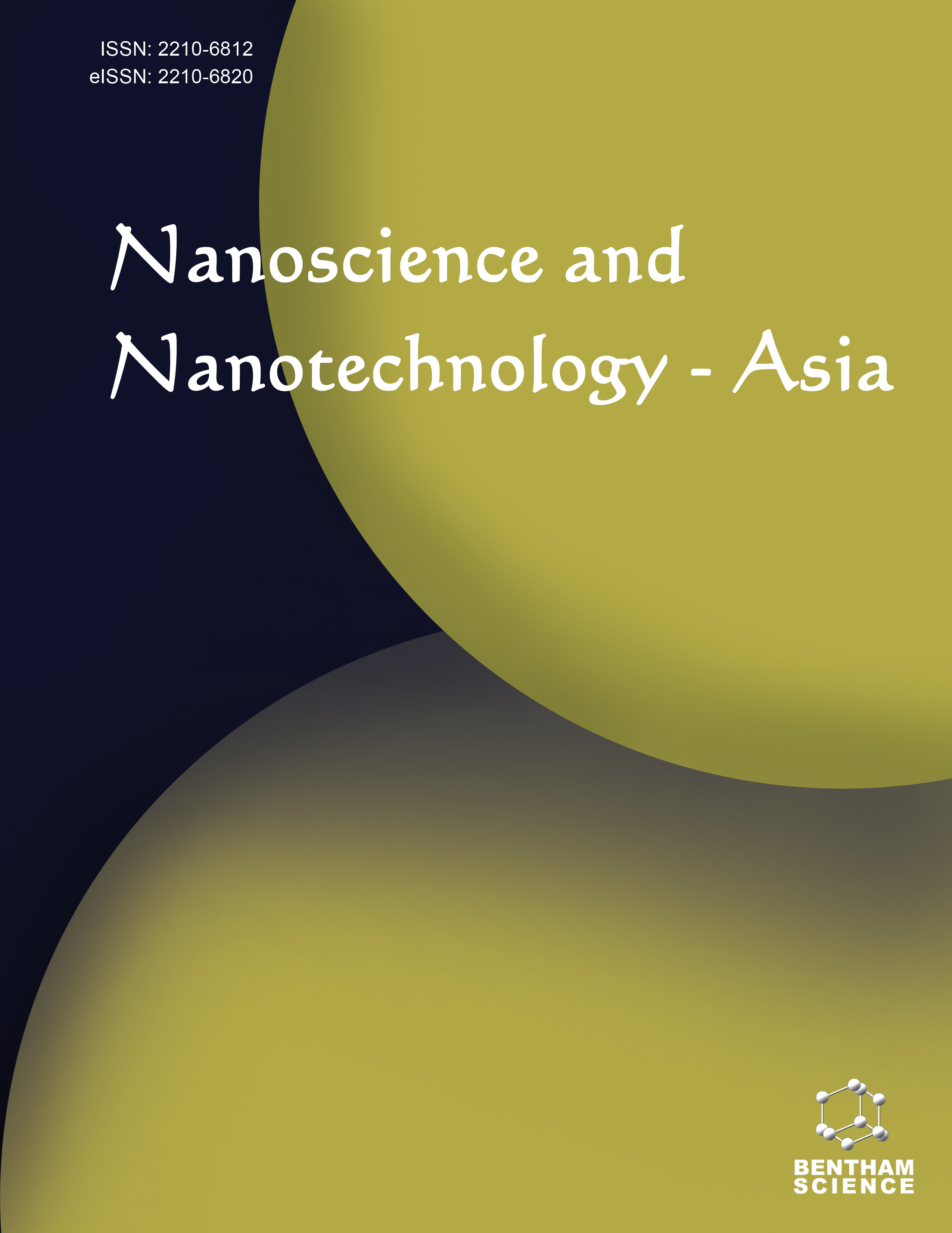- Home
- A-Z Publications
- Nanoscience & Nanotechnology-Asia
- Previous Issues
- Volume 11, Issue 2, 2021
Nanoscience & Nanotechnology-Asia - Volume 11, Issue 2, 2021
Volume 11, Issue 2, 2021
-
-
Biomedical Applications and Patents on Metallic Nanoparticles
More LessAuthors: Geetanjali Singh, Pramod K. Sharma and Rishabha MalviyaAim: The manuscript aims to discuss the advanced biomedical applications and patents on metallic nanoparticles. Discussion: The preparation of metallic nanoparticles and their application are an influential area for research. There are various physical and chemical methods (viz. chemical reduction, thermal decomposition, etc.) for synthesizing silver nanoparticles; biological methods have been suggested as possible eco-fri Read More
-
-
-
Rheological Analysis of CNT Suspended Nanofluid with Convective Boundary Condition Using Spectral Method
More LessAuthors: Soumyodipta Karmakar, Magagula V. Mpendulo and Sabyasachi MondalBackground: In this paper, we have discussed the rheological analysis of the twodimensional stagnation-point flow of carbon nanotubes towards a stretching sheet with water as a base nanofluid with convective boundary conditions based on the advantages of nanofluid flows in CNT. Methods: Our main focus is to study on the rheological analysis of CNT suspended nanofluid with convective boundary condition using spectral me Read More
-
-
-
On the Edge-version of Topological Indices of Titanium Dioxide Nanotube and Nanosheet
More LessAuthors: S. Prabhu, G. Murugan and M. ArulperumjothiBackground: In computational and theoretical chemistry, real numbers programming certain structural skin appearance of natural molecules and derivative from parallel molecular graphs are called the graph invariants or more frequently structural descriptors (topological indices). Methods: Structural descriptors are numeric quantities, which are resulting from a molecular structure by mathematical calculations. Results: In Q Read More
-
-
-
Performance Evaluation of a Vapor Compression Refrigeration System Using Oxide Nano-particles: Experimental Investigation
More LessAuthors: Taliv Hussain, Waquar Ahmad and Intekhab QuadriBackground: Nowadays, the era is of saving energy by working efficiently and effectively. As the temperature of the atmosphere increases globally, there is a keen demand for a vapor compression refrigeration system among people, especially in a region which has fervent climatic conditions. The technology is advancing day by day, thus using the vapor compression refrigeration system efficiently is a way to contribute to savin Read More
-
-
-
Preparation and Evaluation of Gliptin Liposomes for Targetting Ocular Region in Neurodegeneration
More LessAuthors: Deepika Sharma, Swarna Raj, Manmohan Singhal and Bhavna KumarBackground: Neurodegeneration shows the distressing effects of miscommunications between brain cells. Insulin signaling dysregulation and small vessel disease in the base of diabetes may be important contributing factors in Alzheimer’s disease and vascular dementia. Gliptins play a role in neurodegeneration due to its neuroprotective effects. Eye is an extension of the brain. Ocular route reduces drug’s adverse effects offer Read More
-
-
-
Impact of Annealing Temperature on Structural, Optical, and Morphological Properties of ZnO Nanoparticles Synthesized by a Simple Precipitation Method
More LessAuthors: Lalita D. Deshmukh and Kalyan B. ChavanObjective: Herein, we report zinc oxide (ZnO) nanoparticles (NPs) synthesized by a simple precipitation method using zinc acetate dihydrate (Zn(CH3CO2)2. 2H2O) and sodium hydroxide (NaOH) precursors in aqueous media. Methods: Synthesized material was annealed at different temperatures to check phase formation and its purity. Results: At room temperature, the sample shows the formation of zinc hydroxide Read More
-
-
-
Mesoporous Silica Nanoparticles of Hydroxyurea: Potentially Active Therapeutic Agents
More LessAuthors: Kumar Nishchaya, Swatantra K.S. Kushwaha and Awani K. RaiBackground: Present malignant cancer medicines have the advantage of magnetic nanoparticles as delivery carriers to magnetically accumulate anticancer medication in malignant growth tissue. Aim: In the present investigation, silica nanoparticles (MSNs) stacked with hydroxyurea were combined and optimized for dependent and independent variables. Methods: In this study, microporous silica nanoparticles stacked with Read More
-
-
-
The Behavior of Carbon Nano-tubes (CNTs) as a Modifier to Resist Aging and Moisture Damage in Asphalt
More LessAuthors: Mohammad Arifuzzaman, Rafiqul A. Tarefder and Muhammad S. IslamBackground: Moisture damage and aging take place together in asphalt binder as it is on road-pavement in service life and, therefore, quite challenging to overcome. Various techniques, such as crumb rubber, fibers, etc. have been applied to improve the behaviour of asphalt materials. The use of nanomaterials was found as one of the effective techniques to develop temperature performances of asphalt binder. Method Read More
-
-
-
Sol-gel Growth of Ni-doped CdS on Glass Substrates: Effect of Spin Coating Speed and Dopant Concentration
More LessAuthors: Atefeh N. Setayesh and Hassan SedghiBackground: In this work, CdS thin films were synthesized by the sol-gel method (spin coating technique) on glass substrates to investigate the optical behavior of the film. Methods: Different substrate spin coating speeds of 2400, 3000, 3600 rpm and different Ni dopant concentrations of 0 wt.%, 2.5 wt.%, and 5 wt.%) were investigated. The optical properties of thin films, such as the refraction index, extinction coefficient, di Read More
-
-
-
In Vitro Cytotoxicity Evaluation of Oxytetracycline Loaded Cockle Shell Derived Calcium Carbonate Aragonite Nanoparticles
More LessBackground: Evaluation of the toxic effects of nanoparticle-drug in vitro is an important step in the design of new pharmaceutical formulations. Rapid results, reduced cost and easy handling make cell culture models first line in initial toxicological assessment of nano-drug preparations. Objective: To evaluate the in vitro cytotoxicity of oxytetracycline loaded calcium carbonate aragonite nanoparticle in normal mouse fibro Read More
-
-
-
Green Synthesis of Silver, Copper and Gold Nanoparticles Using Terminalia arjuna Bark and their Effect on Seed Germination
More LessAuthors: Rama Sharma and Hariom GuptaBackground: Terminalia arjuna has many biological applications including synthesis of metal nanoparticles, which have no hazardous effect on the environment. We have demonstrated that metal nanoparticles synthesized using Terminalia arjuna bark can be used to enhance the germination of seeds. Methods: To evaluate the effect on germination, we treated Vigna unguiculata (black-eyed peas) seeds with copper, silver and gol Read More
-
Volumes & issues
Most Read This Month
Article
content/journals/nanoasi
Journal
10
5
false
en


